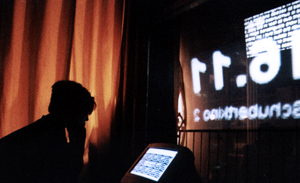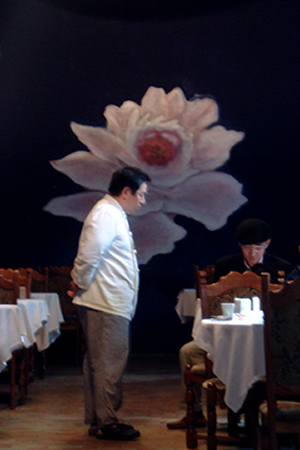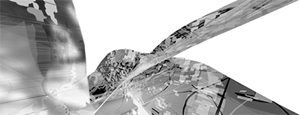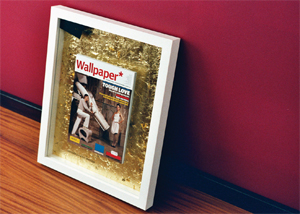| |
- PELZIQ [Franz Sdoutz | Andreas Rumpfhuber]
Img. _01 Electronic Lounge 1997
Img. _03 Electronic Lounge concept drawing 1997
- beige. [Franz Sdoutz | Andreas Rumpfhuber]
Img. _02 Haizaki San No Omise 2001 - 2002
- Franz Sdoutz
Img. _04 Object for the exhibition: » Young Blood: I'm a Young "Austerian" Architect! « 2006 [See File Log]
- 1 At the time (2001) there was outrage in Austria regarding certain architecture(s). I've mentioned two (then) well known examples, where the 'public' had appropriated the discourse (sporting particularly ludicrous arguments):
On the genesis of the 'Viennese Museum's Quarter' [Museumsquartier Wien] by Ortner & Ortner architects (former members of Haus-Rucker-Co) http://www.museumsquartier.de/
- 2 On preventing a 'National Park Centre' [Nationalparkzentrum] in Hainburg by Coop Himmelb(l)au (unfortunately offline.) What the net still remembers …
http://diepresse.com/
- IN:
Medienpraktisch, Heft 1/98, S. 51 - 56.
'Die Talkshow als "säkularisierte Beichte"?' by Rolf Schieder
Online: juergen-fliege.de
3 If talk shows are to be credited with societal functionality, then its conformation: "conventionalisation by means of interpretation". [ » Normierung durch Deutung « ]
- 4 Referring to a lecture by Jacques Herzog
'On Image & Surface' [The power of images'] Autumn 2000, AA London http://www.aaschool.ac.uk/
6 In order to grasp the scope of such conception, one needs to conceive (in catholic ritual) a reproductive usage of communion wine in consecration. [The joke here is to state the obvious. The actual miracle (performed on an everyday basis) is to transform a mass reproducible commodity (wine) into the actual blood of Christ. But, and this is essential, it is not meant for architects to perform miracles (anymore) … Such aspiration is profane.] Of course Herzog & de Meuron give entirely different reasons why that project had failed. http://www.herzogdemeuron.com/
- IN:
ARCH+ 129/130 December 1995 http://www.archplus.net/
5 'Greek Orthodox Church in Zurich' [competition project, 2nd prize] 1989, Herzog & de Meuron [page 49] http://www.herzogdemeuron.com/ [images]
- 'Kopf oder Zahl. Die Poesie des Geldes' by Jochen Hörisch, published by Edition Suhrkamp, Frankfurt am Main - 1998 (published first 1996) http://books.google.at/
7 » Wahr wären demnach Sätze, die Sachverhalte adäquat repräsentieren; gerecht wären demnach Preise, die Wahrenwerten äquivalent wären. Und weil Wahrheit wie Reichtum selten, knapp und wertvoll ist, muß Sprache, die Wahrheit ausdrückt, und muß Geld, das über Preise wertvolle 'Sachen' repräsentiert, knappgehalten werden. « [page 309]
8 » Wahrheit gibt es nicht … « [page 311]
For comparison: Review and discourse by Hartmut Winkler. http://homepages.uni-paderborn.de/
- IN:
ARCH+ 178, Zeitschrift für Architektur und Städtebau, June 2006 http://www.archplus.net/
9 For some enjoyable insights regarding immersion [as management of hallucinations] see 'Architektur als Immersionskunst [Architecture as an Art of Immersion]' by Peter Sloterdijk [pages 58 to 61]
[PDF translated by A.-Chr. Engels-Schwarzpaul
German from 'ARCH+ 178: Die Produktion von Präsenz'
For more Sloterdijk in English http://seansturm.wordpress.com/]
Also interesting: 'Total Immersion' Lecture by Bart Lootsma, London September 2007 PDF [from 404]
- 10 "Meaning [Sinn] " [only] requires observation: DIFFERENCE [from anything not making sense, hence remaining » ineffective autopoietically. « V.) 11]
REPETITION distinguishes from chance V.) 12 [what is unobservable, indistinguishable white noise].
[See Bikini Bottom for translation(s)]
- 'Theory of Society' (Volume 1) by Niklas Luhmann, translated by Rhodes Barrett, published by Stanford University Press in 2012
[published first in German as 'Die Gesellschaft der Gesellschaft' (The Society of Society) by Suhrkamp, Frankfurt am Main, 1997, my paperback edition is from 1998]
http://www.sup.org/ [German]
Volume 1 [Chapter 1-3]
13 » Society is a meaning-constituting system. « [page 21; see Bikini Bottom for translation(s).]
11 » "All communication" even includes paradoxical communication, communication that denies that it says what it says. We can communicate paradoxically and do so without communicating "meaninglessly" (in the sense of ununderstandably = autopoietically ineffectively). « [page 48]
12 » We ascribe no causal-theoretical importance to the concept of chance. In extremely abstract terms, we can speak of chance as a difference-theoretical boundary concept. Chance then means that determination of the one side of a distinction has no meaning for determination of the other side. […] By “chance,” we understand a form of correlation between system and environment that eludes synchronization (i.e., also control, "systematization") by the system. « [page 271]
See also volume 2 [Chapter 4-5]
http://books.google.at/
- 14 With respect to the Guggenheim-Museum Bilbao see: 'On The Bandwagon' written and presented by Jonathan Meades ['Abroad Again'] produced in 2006 by BBC Scotland http://www.youtube.com/ [3/5] [added 2010]
- 15 Referring to prevailing Tech-Talk at the time. (Nielson merely being a prominent figure.) In the era of social networks, over a decade later, when users don't want to be informed, but prefer to participate, the sarcastic undertone still applies.
|










TOP
Social Networks